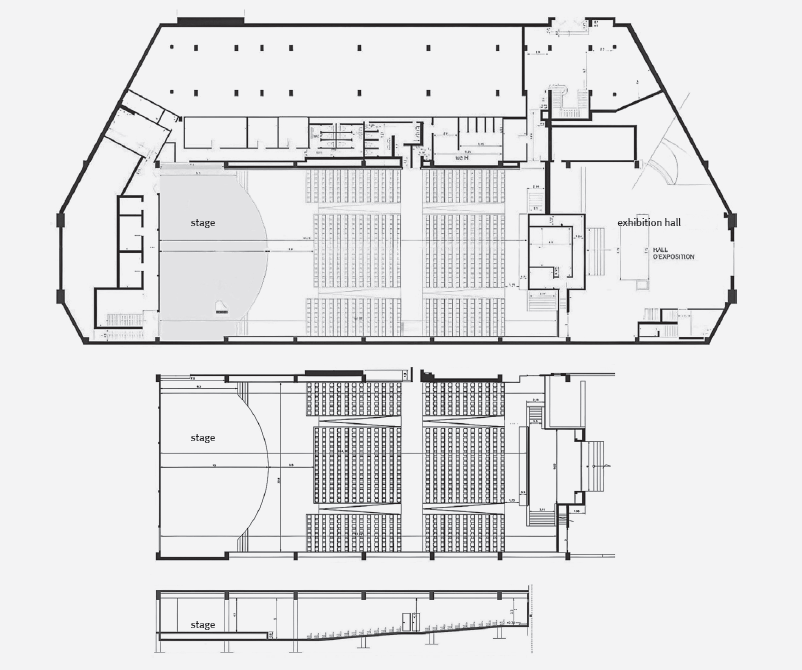Reflectors Impact on Acoustic Correction of the Conference Hall at El Khalifa Cultural Center in Constantine
DOI:
https://doi.org/10.31522/p.33.1(69).12Keywords:
acoustic quality, auditory comfort, conference rooms, El Khalifa Cultural Centre, Constantine, Algeria, plywood reflectors, sound diffusersAbstract
In Algeria, the field of acoustics has garnered limited attention from researchers, predominantly focusing on physical acoustics. Architectural acoustics, which deals with controlling auditory comfort and listening criteria within buildings, remains largely underexplored. The acoustic quality of spaces is a significant concern for physicists, architects, and researchers alike. The application of architectural acoustics in public spaces, such as conference rooms, greatly enhances the exchange of oral information and supports learning processes that require intensive verbal communication. This research aims to improve the acoustic quality of the existing conference room at the El Khalifa Cultural Centre in Constantine, Algeria. It has been noted that the centre experienced a reduction in reverberation time and sound diffusion due to an acoustic rehabilitation that introduced wall coverings of mixed panels composed of heavily perforated MDF and a layer of foam (8 cm thick). However, this rehabilitation resulted in the conference room becoming overly “deaf”, diminishing its acoustic quality. In order to address this issue, we proposed the installation of a network of six plywood reflectors, each 12 mm thick, placed on the ceiling of the room in the xy plane, with dimensions of 3×2.67 m2 each. Subsequently, the acoustic characteristics of the plywood reflectors were incorporated into the material database of the Olive Tree Lab Suite software to evaluate their impact on the room’s acoustic performance and the quality of sound diffusion. The results for reverberation time (TR60), clarity (C80), strength (G), definition (D50), and speech transmission index (STI) were highly satisfactory and aligned perfectly with the recommended values. Therefore, the acoustic correction significantly improved the listening conditions.
References
Barron, M. (2010) Auditorium Acoustics and Architectural Design. Edited by Routledge. https://doi.org/10.4324/9780203874226
Economou, P. and Charalampous, P. (2016) ‘Improved Room Acoustics Calculations Using Complex Impedance and Spherical Wave Reflection & Diffraction Coefficients’, The 23rd International Congress on Sound and Vibration, Athens, Greece.
Farid Ibrir, D. and Debache Benzagouta, S. (2017) ‘Sustainable acoustic rehabilitation of conference rooms: impact of straw on the acoustic correction of the conference room of the Malek Haddad cultural center in Constantine’, Sciences & Technologie , pp. 183-191.
Farid, D. (2021) ‘OEB Univ. Publish. Co.’, Journal of Human Sciences Oum El Bouaghi University, 08(03).
Farid, D.; Debache Benzagouta, S. and Remram, Y. (2021) ‘Experimental study for acoustic correction of a school classroom using the alfa panel’, International Journal on “Technical and Physical Problems of Engineering” (IJTPE), June, pp. 48-53.
Galbrun, L. and Kitapci, K. (2016) ‘Speech intelligibility of English, Polish, Arabic and Mandarin under different room acoustic conditions’, Applied Acoustics, 114, pp. 79-91. Available at: https://doi.org/10.1016/j.apacoust.2016.07.003
Hongisto, V. et al. (2021) ‘Precision of ISO 3382-2 and ISO 3382-3 - A Round-Robin test in an open-plan office’, Applied Acoustics, 175, p. 107846. Available at: https://doi.org/10.1016/j.apacoust.2020.107846
Jo, H.I.; Lee, K., and Jeon, J.Y. (2022) ‘Effect of noise sensitivity on psychophysiological response through monoscopic 360 video and stereoscopic sound environment experience: a randomized control trial’, Scientific reports, 12(1), p. 4535.
Labia, L.; Shtrepi, L. and Astolfi, A. (2020) ‘Improved Room Acoustics Quality in Meeting Rooms : Investigation on the Optimal Configurations of Sound-Absorptive and Sound-Diffusive Panels’, acoustics, pp. 451-473. Available at: https://doi.org/10.3390/acoustics2030025.
Mediterranean Acoustics (no date) Olive TreeLab Suite. Available at: https://www.mediterraneanacoustics.com/olive-tree-lab-suite.html (Accessed: 1 August 2024).
Rindel, J. (2001) ‘Scattering in Room Acoustics and Related Activities in ISO and AES’, 17th ICA Conference, Rome, Italy.
Rindel, J.H. (2004) ‘Evaluation of room acoustic qualities and defects by use of auralization’, The Journal of the Acoustical Society of America, 116(4), p. 2483.
Shtrepi, L. et al. (2017) ‘Effects of the Distance from a Diffusive Surface on the Objective and Perceptual Evaluation of the Sound Field in a Small Simulated Variable-Acoustics Hall’, applied sciences Article [Preprint]. Available at: https://doi.org/10.3390/app7030224.
Shtrepi, L.; Di Blasio, S. and Astolfi, A. (2020) ‘Listeners Sensitivity to Different Locations of Diffusive Surfaces in Performance Spaces: The Case of a Shoebox Concert Hall’, Applied Sciences, 10(12). Available at: https://doi.org/10.3390/app10124370.
Szeląg, A. et al. (2020) ‘Reflective panels with Schroeder diffusers - a measure to broaden the effective frequency range of sound reflection from overhead stage canopies’, Applied Acoustics, 157, p. 107034. Available at: https://doi.org/10.1016/j.apacoust.2019.107034.
Yan, L. and Chen, Y. (2012) ‘Finite Element Simulation in Fabrication of High Precision Reflector Panels’, Proceedings of SPIE - The International Society for Optical Engineering, 8450. Available at: https://doi.org/10.1117/12.925116.

Downloads
Published
Issue
Section
License
Copyright (c) 2025 Dalal Farid, Amina Naidja , Khalid Zaouia, Yasser Nassim Benzagouta

This work is licensed under a Creative Commons Attribution 4.0 International License.
Copyright (c) 2021 authors and journal.
This work is licensed under a Creative Commons Attribution 4.0 International License.
Authors who publish with this journal agree to the following terms:
In agreeing this form, you certify that:
- You read the ethical codex of the PROSTOR available at journal web.
- You submitted work is your original work, and has not previously been published and does not include any form of plagiarism.
- You own copyright in the submitted work, and are therefore permitted to assign the licence to publish to PROSTOR.
- Your submitted work contains no violation of any existing copyright or other third party right or any material of an obscene, libellous or otherwise unlawful nature.
- You have obtained permission for and acknowledged the source of any illustrations, diagrams or other material included in the work of which you are not the copyright owner.
- You have taken due care to ensure the accuracy of the work, and that, to the best of your knowledge, there are no false statements made within it.
- All co-authors of this submitted work are aware of, and in agreement with, the terms of this licence and that the submitted manuscript has been approved by these authors.






